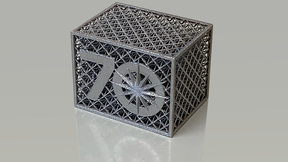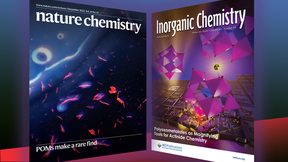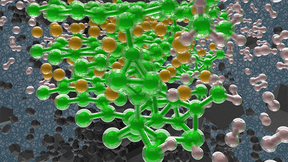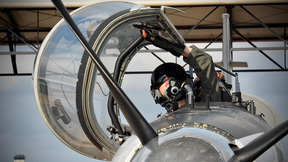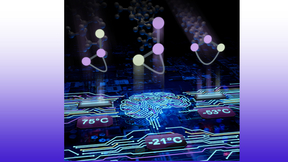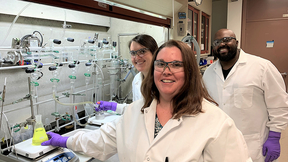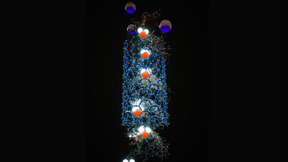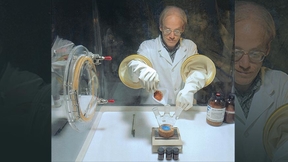Back
Through machine learning, a Lawrence Livermore National Laboratory (LLNL) scientist has a better grasp of understanding materials used to produce hydrogen fuel. Water is everywhere in the environment and its interaction with metal oxide surfaces has a key role in processes that range from wetting, dissolution and corrosion to photocatalytic reactions. The relative…
Part 5 in a series of articles describing the elements of Lawrence Livermore National Laboratory's fusion breakthrough. If Lawrence Livermore National Laboratory (LLNL)’s National Ignition Facility (NIF) were a race car, it would run at the redline most of the time. “NIF is the only laser system that intentionally operates above the laser damage growth threshold,” said…
When it comes to studying particles in motion, experimentalists have followed a 100-year-old theory that claims the microscopic motion of a particle is determined by random collisions with molecules of the surrounding medium, regardless of the macroscopic forces that drive that motion. Scientists at Lawrence Livermore National Laboratory (LLNL) and the Massachusetts…
The nitrate runoff problem, a source of carcinogens and a cause of suffocating algal blooms in U.S. waterways, may not be a harbinger of doom. A new study led by the University of Illinois Urbana-Champaign and researchers from Lawrence Livermore National Laboratory (LLNL) demonstrates an approach for the integrated capture and conversion of nitrate-contaminated waters into…
Lawrence Livermore National Laboratory (LLNL) engineers and scientists have developed a method for detecting and predicting strut defects in 3D-printed metal lattice structures during a print through a combination of monitoring, imaging techniques and multi-physics simulations. The high-strength and low-density properties of metallic lattices have found applications in…
Neuromorphic computing aims to mimic the energy-efficient information processing of the human brain. To enable brain like processing, a new device architecture that forgoes the rigid computing language of zeros and ones is needed. This brings the question, what if devices used ions moving in fluids to carry and store information? MSD’s Alex Noy co-authored a perspective…
Studying radioactive materials is notoriously difficult due to their radiation-induced toxicity and risk of contamination when handling. The cost of the radioactive isotopes used in research also is a major barrier, with some costing more than $10,000 per microgram. Certain radioisotopes also cannot be produced in sufficient quantity so it is simply impossible for…
Lawrence Livermore National Laboratory (LLNL) employees, participating in five project teams, recently earned Department of Energy (DOE) Secretary’s Honor Achievement Awards. Representing some of the highest internal, non-monetary recognition that DOE employees and contractors can receive, the Secretary’s Honor Awards recognize DOE employees and contractors for their…
A collaboration including scientists from Lawrence Livermore National Laboratory (LLNL), Sandia National Laboratories, the Indian Institute of Technology Gandhinagar and Lawrence Berkeley National Laboratory has created 3-4 nanometer ultrathin nanosheets of a metal hydride that increase hydrogen storage capacity. The research appears in the journal Small. There is a need…
Second Lt. Hannah Fletcher, a 2021 Lawrence Livermore National Laboratory (LLNL) Reserve Officer Training Corps (ROTC) summer intern, has been named the 2022 United States Air Force (USAF) Cadet of the Year. This award recognizes the best cadet in an Air Force commissioning program based on military performance, academics and physical fitness. LLNL’s ROTC internship…
Lawrence Livermore National Laboratory materials scientist Daniel Schwalbe-Koda has been named one of Forbes “30 under 30” for 2023 in the science category. Forbes features a list of 600 individuals under the age of 30 each year, who have impactful careers and/or accomplishments across a span of industries — healthcare, science, consumer technology, Hollywood, retail,…
Lawrence Livermore National Laboratory (LLNL) scientists have created vertically aligned single-walled carbon nanotubes on metal foils that could be a boon for energy storage and the electronics industry. Vertically aligned carbon nanotubes (VACNTs) have exceptional mechanical, electrical and transport properties in addition to an aligned architecture, which is key for…
Hundreds of millions of tons of polymer materials are produced globally for use in a vast and ever-growing application space with new material demands such as green chemistry polymers, consumer packaging, adhesives, automotive components, fabrics and solar cells. But discovering suitable polymer materials for use in these applications lies in accurately predicting the…
Under normal conditions, radioactive materials such as uranium work in a predictable manner. But take those same materials and put them under extreme conditions with high temperature in a short timescale and a rapid cooling process and their decomposition pathways change dramatically. Lawrence Livermore National Laboratory (LLNL) scientists built a unique process to…
Transforming the way energy is collected, stored and used has become a defining challenge of the 21st century. To address this task, the Department of Energy’s (DOE) Office of Basic Energy Sciences (BES) established the Energy Frontier Research Center (EFRC) program. This year, Lawrence Livermore National Laboratory and collaborators were awarded three projects. The first…
Lawrence Livermore National Laboratory (LLNL) scientists are scaling up the production of vertically aligned single-walled carbon nanotubes (SWCNT) that could revolutionize diverse commercial products ranging from rechargeable batteries, automotive parts and sporting goods to boat hulls and water filters. The research appears in the journal Carbon. Most CNT production…
Safe, long-cycle-life batteries with high energy density are greatly needed with the rapid growth of electric devices and vehicles and grid energy storage demands. Lawrence Livermore National Laboratory (LLNL) scientists have devised a method for the fabrication of all-solid-state lithium metal batteries, which have been recognized as the future choice of safe and high…
Producing fragrances and flavorings and converting chemicals derived from biomass could get a boost from a new technique to break up hydrogen in nanoporous copper-titanium catalysts. The dissociation (breaking up) of hydrogen bonds is an essential elementary step in catalytic hydrogenation (a chemical reaction between molecular hydrogen [H2] and another compound or element…
On September 20, LLNL hosted its annual Postdoc Research Slam. This Lab-wide competition encourages postdocs to showcase their research in a three-minute presentation that answers the question, “Why is my research important?” The event gives postdocs the opportunity to improve their communication and speaking skills and challenges them to articulate their research in an…
The last nuclear test, code-named Divider, took place 30 years ago, on Sept. 23, 1992. That year, President Bush declared a temporary moratorium on nuclear testing, which became permanent in 1995, during the Clinton administration. This ending of the era of nuclear testing coincided with a Presidential announcement of the beginning of stockpile stewardship. As the decision…





